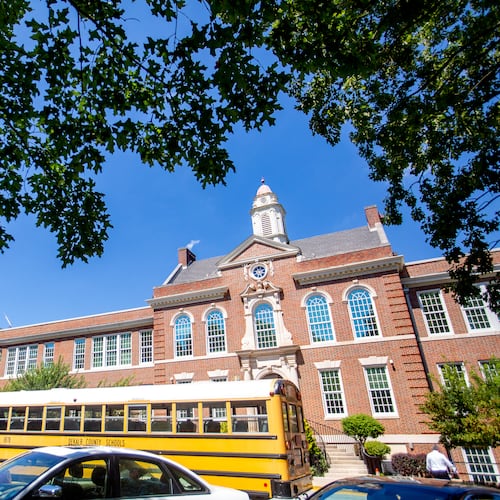I have been writing about Georgia education long enough to no longer be surprised by the difference in the political rhetoric – “We want world-class schools” – and the political reality – “But we don’t want to pay for them.”
A new report from the American Federation of Teachers underscores the conflict in Georgia between aspirations and appropriations.
Let me first address the argument money does not matter. It does, which is why Georgia’s highest-performing private schools charge upwards of $22,000 a year, and that is for a student body largely comprised of affluent children who arrive with every possible advantage.
Readers often cite the city of Atlanta, saying it spends more per pupil than other districts and gets mediocre results. Many APS students come from poor families and arrive with social disadvantages and learning deficits that can be overcome, but require smaller class sizes, longer days and targeted help – all of which cost money.
Georgia does attempt to even the playing field with programs that provide extra dollars to districts with a lot of low-income students. One study found poor students in Georgia, on average, earn $282 more than non-poor students.
However, those additional dollars aren't enough, as the Georgia Partnership for Excellence in Education noted in its report, Top 10 Issues to Watch in 2018.
Where Georgia struggles is on the adequacy question…While the 2018 state budget represents an increase of $714 million for education from the General Fund, Georgia ranks 38th in spending per student and invests $1,965 less per student than the national average.
Since 2003, K-12 public education has experienced a cumulative cut of more than $9.2 billion. Students living in poverty frequently need extra supports from the school systems to meet high levels of academic achievement. Strategies such as longer school days and years and smaller class size can help low-income students catch up with their more affluent peers.
With those caveats, I want to share some key findings from the AFT report, “A Decade of Neglect: Public Education Funding in the Aftermath of the Great Recession.”
When you control for inflation, there are 25 states that spent less on K-12 education in 2016 than they did prior to the recession including Georgia.
Chronic underfunding explains why, in 38 states, the average teacher salary is lower in 2018 than it was in 2009, and why the pupil-teacher ratio was worse in 35 states in 2016 than in 2008.
States prolonged the damage by cutting taxes for the rich at the expense of public schools.
Here is an excerpt from the report that speaks to Georgia:
Eighteen of the 25 states that provided less funding for K-12 education reduced their tax effort between 2008 and 2015. The 10 worst states for per-pupil funding in 2016 either reduced their overall tax effort or took action that had a net negative impact on revenue after 2008. Eight of the 10 states with the largest reductions in education funding compared with 2008—Alabama, Arizona, Florida, Georgia, Idaho, Kansas, Oklahoma and Virginia—reduced their overall tax effort.
In Georgia, 70 percent of schools have shortened the school year, 80 percent of districts have had to furlough teachers, 62 percent have eliminated electives, 42 percent have eliminated art and music, and 70 percent have cut professional development for teachers.
Among the 50 states, Georgia had the second-largest reduction in state per-student education funding following the recession. Austerity cuts had been put in place in 2003 and by 2018, more than $9 billion had been cut from Georgia's schools.
Comparing 2008 and 2015, the state reduced its tax effort by 12.7 percent, the fourth worst reduction in the nation. The impact on education was severe. The state was spending almost 13 percent less on K-12 education in 2016 compared with 2008, adjusting for inflation. And, by 2017, real state spending on higher education was down 16 percent.
At the same time Georgia lawmakers were cutting taxes, they were also working to shift more tax dollars to private schools.
In 2008, legislators created the Georgia Qualified Education Expense Tax Credit, which allowed tax filers to receive a dollar-for-dollar reduction in their state income tax bill up to $1,000 if they are single and $2,500 if they are married, in exchange for donations to private voucher granting organizations. Corporations can receive a credit up to 75 percent of their tax liability in exchange for contributions to the organizations. The statewide cap on the total tax credit is $58 million in 2018; it increases to $100 million in 2019.
This year, Georgia lawmakers finally put a stop to funding cuts and added $167 million to the 2019 state budget, which will fully fund the state's K-12 funding formula for the first time since 2003. However, advocates say that full funding under the Quality Basic Education formula itself falls short of adequate because districts have been absorbing transportation and health insurance costs from the state.
Georgia lawmakers may well find themselves unable to follow through on their commitment to fully fund Georgia's schools. In March, the governor signed tax cut legislation that is projected to reduce revenues by more than $1 billion a year. The new tax law lowers the corporate tax rate and the top individual income tax rate.
About the Author
Keep Reading
The Latest
Featured




